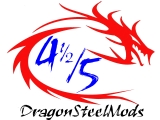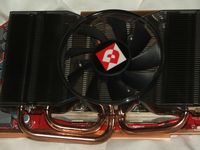Videocards are something that have
always kind of annoyed me, it seems they’re always releasing a new
one, technology that was hot a few months ago is now obsolete. Then
again, that’s the way it is with most technology so I’m not sure why
it surprises me, but it, the upgrades, just seems to go much faster
with video cards.
Today for review I’ve got the Diamond
ATI Radeon 4870 1gig video card. As you can see be the name it
features 1 gig of ram, so I figured why not make this more of a
comparison review as in how much performance do you gain when going
from 512mb to 1gig of ram. So I put my Sapphire 4870 512mb card up
against the Diamond, both are running the same core and memory
speeds, so they’re pretty much the same cards except for the on board
ram they have. So read one to find out if it’s worth it to grab the
1gig over the 512mb version card…
Product
Name: DIAMOND
ATI Radeon HD 4870 PCIE 1024MB GDDR5 Video Card 4870PE51G
Author: Kristofer Brozio
Sponsor: Diamond
Tech
Specs,Features or the Basic Info:
DIAMOND
ATI Radeon HD 4870 PCIE 1024MB GDDR5 Video Card 4870PE51G
[SKU : 4870PE51G]
The Diamond HD 4870 is a
magnificent beast. A 956 million-transistor processing powerhouse, a
technology statement and dream come true for enthusiast gamers hungry
for the fastest GPU ever made. Featuring a 2nd generation unified
shader architecture, massive processing power and an unprecedented
256-bit memory interface, HD 4870 will deliver astonishing
performance and the richest feature-set yet for a big ultra-high
definition gaming experience with all of the bells and whistles
turned up to the max. The HD 4870 is quite simply a ticket to the
future of PC gaming.
* Play the latest PC games
supporting DirectX 10.1, the latest generation of gaming graphics.
* Work & Productivity
Application
* Video playback and editing.
* HD video playback (Blu-ray
and HD DVD) and editing.
* Everyday home computing
applications (such as Vista, photos, standard videos, and games).
Performance:
GPU : HD 4870
ASIC Core : RV 770
Core Clock : 750 MHZ
BUS : PCI Express x16
Ports : 2 Dual-Link DVI,Video
Out [S-Video, Composite, HDTV]
Cooling : Active – FanCooler
MFG Process : 55nm fabrication
process
Transistor Count : 956 million
Stream Processors : 800
Memory:
Memory Clock : 900 MHz
Memory Configuration : 32Mx32
Memory Type : GDDR5
Memory Bandwidth : 160.9 GB/sec
Memory Size : 1024MB
Memory Interface : 256-Bit
RAMDAC : Dual 400Mhz
Video
Quality:
CrossFire : CrossFire X
QuadFire Support : YES
Direct-X : 8.0,9.0,10.0-10.1
Open GL : OpenGL 2.0
Vide Acceleration : MPEG-2,
MPEG-4, DivX, WMV9, VC-1, and H.264
Max Resolution Analog : 2048 X
1536
Max Resolution Digital : 2560 x
1600
HDR F.Point Rendering : 128
HDR Integer : 16-bit integer or
floating point
Standard Slot Solution : DOUBLE
Anti Aliasing Modes :
Anti-aliasing features * Multi-sample anti-aliasing (2, 4, or 8
samples per pixel) * Up to 24x Custom Filter Anti-Aliasing (CFAA) for
improved quality * Adaptive
super-sampling and multi-sampling * Gamma correct * Super AA (ATI
CrossFireX™ configurations only) * All anti-aliasing features
compatible with HDR rendering
Antisotropic Modes : 4x
Texture Support : Texture
filtering features * 2x/4x/8x/16x high quality adaptive anisotropic
filtering modes (up to 128 taps per pixel) * 128-bit floating point
HDR texture filtering * sRGB
filtering (gamma/degamma) * Percentage Closer Filtering (PCF) * Depth
& stencil texture (DST) format support * Shared exponent
HDR (RGBE 9:9:9:5) texture
format support
Display
Support:
HDTV : YES
HDMI : HDMI 1.2 / HDMI Ready
HDMI MODE : Dongle
Native Display Support : 18-,
24-, and 30-bit
3D Resolution : 2560×1600
TV-OUT Resolution : 720
Dual Display support :
Hydravision 4
Holywood Q.VIDEO : YES
Package
Content:
DIAMOND HD 4870 PCIE 1024MB
GDDR5 VIDEO CARD
Quick Start Guide
INSTALL CD
Component HDTV ADAPTER
CROSSFIRE Bridge Interconnect
DVI-TO-VGA ADAPTER
DVI-TO-HDMI ADAPTER
General
Product Information:
Form Factor (Profile) :
Standard Profile Full-Height
Product Dimension : 11.75 X 9.5
X 3
Product Weight : 1.8 LBS
SKU : 4870PE51G
UPC : 757448006483
A
Better Look at Things:
The Diamond Radeon 4870 comes in a
nice sleek black box, with Ruby on it of course.
Includes with the card is a
software disc, crossfire bridge, DVI/VGA adapter, DVI/HDMI adapter,
component HDTV cable, quick start guide, RCA video adapter, and some
other pointless literature.
The card itself is a big card,
most of the newer generations are these days so it’s not surprising,
and it uses two 6-pin PCIE power connections.
It’s a dual slot card so on the
back you’ll find hard of the PCI slot is covered with ventilation
slits, while the other half is your connectors.
The cooler on this card is
actually smaller than the ‘stock’ plastic shroud style cooler on
other 4870 cards. This one features three copper heatpipes going up
through many aluminum fins, and a fan in the middle to blow air out
all sides of the card.
(*edit, just realized that picture
is blurry… oops, oh well, not taking it back out now to take one
picture…)
{mospagebreak title= Installation, Testing and Comparison}
Installation,
Testing and Comparison:
Installation is like installing
any other video card really, just pop it in and plug in the power
connectors. The 4870 has two 6-pin PCIE power connections, so you’ll
need to make sure your power supply is equipped with them. The
Diamond 4870 is a dual slot card, so be prepared to lose access to
the slot below the card. The cooler on the 4870 1gig is not quite as
big as the cooler that comes with the Sapphire 4870 512mb that I also
have installed. I like the look of the Diamond cooler much better, it
seems as though I should work better at keeping the card cooler than
the stock plastic shroud type cooler.
I’m basically testing the 512mb
version versus the 1gig version of essentially the same card, same
speeds, 750/900, same size, just a memory difference for the most
part.
I didn’t get into too much
testing, didn’t want to bore anyone, but I got the main stuff here,
gaming and processing capabilities are covered.
First up we’ve got the old
favorite, 3dMark06:
As you can see there is a jump in
performance when using 1 gig as opposed to just 512mb, quite a bit of
a jump for 3dMark.
Next up is testing with Crysis
Warhead.
Resolution: 1680×1050
2x AA
Gamer Settings
DX10
3 runs averaged out
Here we see we gain of about 5
frames per second on average when moving to the 1gig card.
The next three tests involve using
SiSoft Sandra 2009 SP3. Included with Sandra are some video card
related tests that can tell us quite a bit about the cards and their
performance.
First up we have GPGPU Processing
Benchmark the graphics
performance of the graphics processors (GPGPUs).
Such operations are used by
specialised software, e.g. scientific software, image manipulation,
video decoders/encoders, games that make GPU performance pretty
important.
Results Interpretation
Processing Float (Pixels/s) –
higher results are better, i.e. better single (32-bit) floating-point
performance.
Processing Double (Pixels/s) –
higher results are better, i.e. better double (64-bit) floating-point
performance.
Here we see the Diamond 4870 has a
nice improvement in performance over the 512mb card.
Graphics (GPGPU) Bandwidth
Benchmark the bandwidth of the
memory of the graphics processors (GPGPUs) and the bandwidth of the
bus that connects them to your computer.
The speed at which the data can
be sent to the GPGPUs, internally processed and the results sent back
is as important as the processing power of the GPGPUs. The benchmark
is based on the well-known STREAM memory benchmark, as implemented by
the CPU memory benchmarks.
Results Interpretation
Internal Memory Bandwidth
(MB/s) – higher results are better, i.e. faster internal memory
bandwidth.
Data Transfer Bandwidth (MB/s)
– higher results are better, i.e. faster data transfer between the
GPU and computer.
Here again we see the 1gig card
pulling a bit ahead, but not by much.
Video Rendering
Benchmark the graphics
performance of the video adapters (GFXs).
Such operations are used by all
graphics software, image manipulation, video decoders/encoders, games
and modern operating systems.
Results Interpretation
Float Shaders (Pixels/s) –
higher results are better, i.e. better single (32-bit) floating-point
performance.
Double Shaders (Pixels/s) –
higher results are better, i.e. better double (64-bit) floating-point
performance.
Here we see the scores are kind of
close really again. So in regards to the actual graphics performance
of the cards, they are fairly close, but still the Diamond takes the
lead, but only by a slim margin.
Summary
and Comments:
When wanting to know if it’s worth
it to go with the 1gig of ram over the 512mb of ram, the answer is a
resounding yes. The difference between the cards isn’t astronomical
but, when it comes down to picking a graphics card, even the smallest
winning margin is well worth it as it can mean the difference between
playable games and unplayable ones.
The Diamond 4870 1gig card is one
that I can recommend, and since the new 4890 cards have comes out the
prices on these have dropped, making now the time to grab one.
The card runs cool and quiet even
under load, the Sapphire 4870 I have can get very loud when it’s
under load, this is apparently the fault of the cooler that’s on it.
The Diamond card obviously has the better cooler as it does not have
to work as hard to keep the card cool, so the fan isn’t running at
high speed as soon as you start up a game., and your PC doesn’t sound
like a small airplane taking off. You can of course go in and change
the fan speed settings etc, but the average user isn’t going to do
that, or even know they can, so having a card quiet a stock fan speed
settings is very nice.
DragonSteelMods gives the Diamond
4870 1gig card a 4.5 out of 5 score and our Recommended Award as
well.


Pros:
+Quiet even under load
+Runs cool
+Decent performance
+Nice extras included
Cons:
-Big, heavy card
-Takes up two slots
review# 578





















